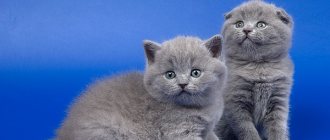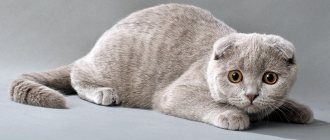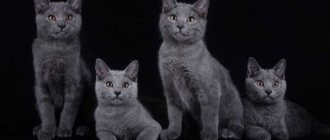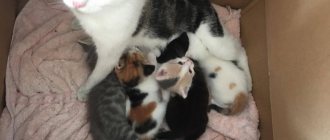Origin story
Presumably, the “Persians” owe their long hair, since representatives of the Persian breed participated in selection with the British. The first matings were carried out in the 60s. XX century.
At first, fold-eared kittens were considered a waste, but every year such a marriage appeared more and more often, so in 1986 the first small Highland with folded ears was shown on television in America.
After this, the Highland Fold breed began to be taken seriously and soon the first representatives of the Fold began to appear at exhibitions. But official recognition dates back only to 1993.
Today, finding Highlands is problematic, because they are quite rare, unlike the eared short-haired brothers of the Scottish Fold.
In Russia there are special nurseries where only this breed is bred. But the Folds never managed to gain recognition - many exhibitions do not consider these cats as a breed, or reject participation due to their non-standard color.
History of the breed
The breed standard was officially registered in 1993 and is today recognized by most influential organizations. The history of selection of fold-eared long-haired cats began much earlier, in the 60s of the 20th century.
One day, the most ordinary cat gave birth to offspring, in which one of the cats turned out to have funny, floppy ears and long white hair. This happened in an area of Scotland called the Highlands, which gave the name to the breed.
At first, lop ears were considered a sign of marriage, but then such cats began to be specially bred.
It is believed that the gene for folding ears was inherited from Scottish cats from Persian ancestors. The fact is that Persians were crossed with the British in order to improve and consolidate the breed characteristics of the latter. British cats, in turn, were involved in the breeding of the Scottish Fold, the “big brother” of the Highland Fold.
Description of the breed
Highland Folds have almost the same standards as Scottish Folds, differing from them only in ears and coat. At exhibitions, this breed is presented as one of the varieties of Scottish Fold Longhair cats.
| Body | Small, round and flexible. Animals have developed muscles and a wide chest. In size, cats are slightly larger than cats. |
| Wool | Thick, fluffy and short. Feature – the “collar” and “pants” stand out very well. The wool itself is silky and soft. Rare colors - solid black and white animals. The most common folds are smoky, tortoiseshell, as well as spotted tabbies and harlequins. |
| Head | A wide head is proportional to the body according to standards. |
| Eyes | Widely spaced, round, mostly yellow in color. |
| Ears | Small, pressed against the head, with rounded ends. Folded in half, directed towards the middle of the muzzle. It is the ears that distinguish them from other breeds. |
| Limbs | The legs are short but powerful. The front ones have five toes, the rear ones have four. The tail is thick, bends easily, long, measuring at least 2/3 of the length of the body; with a smaller tail size, cats are considered defective. |
Health
Highland Fold cats rarely get sick. The most common diseases:
- One of the main pathologies that is specific to folds is osteochondrodysplasia. It cannot be cured. It appears when the animal was mated incorrectly. As a result, the cat begins to limp, it cannot jump, as a result, the limbs become deformed, and development slows down. When contacting veterinarians, the pet is prescribed special medications that alleviate the condition and prevent the development of an incurable disease.
- Another disease that is typical of Highland Folds is urolithiasis. It appears mostly in males, especially in those who have already been castrated. If you notice that your cat is experiencing pain when urinating, he is bleeding, and he is constantly licking his genitals, then immediately show him to the veterinarian. If you apply a warm heating pad to the animal's belly, you can slightly reduce the pain and cramps.
- Heart pathologies also occur in this breed of cats. This manifests itself in symptoms such as shortness of breath, difficulty breathing, and irregular heart rhythm. For cardiomyopathy, it is necessary to follow appropriate therapy and monitor diet and lifestyle.
- Another problem with Scottish breeds is obesity. Therefore, pay attention to ensure that your pet eats properly and does not overeat. This way you can prevent this disease.
- Many Highland owners know firsthand about inflammation in the ears and eyes of their pets. If a problem is detected in time, it can be eliminated very quickly.
It is also worth paying attention to timely vaccinations and taking antihelminthic medications.
Scottish Fold cat health
Highland Folds have a fairly high immunity to most diseases. But there are a number of problems that these kittens can face.
Osteochondrodysplasia
This is a serious, incurable pathology. Most often this problem occurs due to incorrect knitting. This disease provokes lameness, disorientation in space, deformation of the limbs, and delayed development.
In order to alleviate the course of the disease, veterinarians prescribe special medications. They stabilize the general condition of the cat and prevent further progression of the disease.
Urolithiasis disease
This is another problem that often occurs in Scottish Fold longhair cats. Males, especially neutered ones, suffer from it more often than male cats.
If an animal has difficulty going to the toilet, or there are particles of blood in its urine, immediate intervention by a specialist is necessary. If this is discovered late in the evening, when the doctor is no longer attending, the owner can put a warm heating pad on it to relieve the spasm and ease the animal's suffering.
Heart diseases
This problem is less common in the Scottish Highlands. Its main manifestations are shortness of breath and irregular heartbeat. The doctor will prescribe recommendations on the pet’s diet and lifestyle.
Obesity
It's a problem for all Scots. This can only be prevented by proper nutrition, the principles of which cannot be deviated under any circumstances.
Important! You also need to monitor the condition of the eyes, wipe them and care for them. But various drops, the choice of which is very large today, will help cope with eye diseases.
Character
All Highlands are very pliable and have a calm character. They are friendly towards all family members and absolutely non-aggressive.
They are very attached to the house and to the owner, they love care and attention to their person. But they won’t impose themselves either. They easily accept other pets and get along well with children, although there is a lot of talk about their touchiness and jealousy.
They don’t hide in front of guests, don’t run away, easily allow themselves to be petted and love to show off. The characteristic features of folds are:
- good learning ability;
- curiosity;
- understanding;
- calm;
- good nature;
- sociability.
Possible problems
Scottish Fold Highland Fold cats very rarely create problems for their owners. But sometimes this happens.
- If anyone in the family has allergies, you should not get this breed, because long hair will cause nightmares, and your beloved pet will have to be placed with another family.
- Fold long-haired cats of the Scottish breed are very jealous by nature, so if the owners have several pets at once, then they will have to pay equal attention, or show more love to the jealous fold cat.
- They require increased attention, so they do not like to be left alone for a long time. If your job does not allow you to spend a lot of time at home, then it is better not to start a fold.
- These cats are real creeps. The temperature of the room where they live should not be less than 18–20 degrees. At lower temperatures, they easily catch cold and freeze, although they have thick fur.
Rules of care and feeding
Despite the fact that Highland Fold cats have fairly long hair, they do not require much care from their owners.
Care
Cats only need to be brushed once a week and bathed once a month.
Before bathing, be sure to clean their ears with special cotton swabs, comb their fur lengthwise, and then apply a special degreasing paste to the fur. After this, rub it in with massaging movements for 5 minutes and rinse thoroughly with warm water. Then massage super-cleansing shampoo into the coat and rinse again with water.
To highlight the beauty of their coat, it is recommended to apply a texturizing shampoo and rinse thoroughly with warm water. Finally, apply a texturizer to the coat, which will prevent the hair from sticking together and give it a beautiful volume.
Dry the wool with an air dryer, using only a warm stream of air.
Feeding
The beauty of their coat, as well as their general condition, depends on proper feeding. First, you need to decide what type of food you want to give your preference. If your choice fell on industrially produced feed, then the manufacturers have already thought about its quality for you - it is thought out in terms of calorie content and is always balanced.
You can also select food for animals of different ages, but always premium quality. There should always be some water near the bowl of food, which needs to be changed at least 4 times a day. Most owners of this uniquely beautiful breed prefer natural products. The Highland Folds diet should include:
- boiled sea fish
- lean meats
- offal
- porridge, fermented milk products, with the exception of cream and sour cream
- boiled or raw vegetables with the addition of vegetable oil, which promotes better absorption of vitamins.
Care
Caring for Highlands does not require any specific skills. Even if this is your first pet, you should know that caring for it will be very easy.
Wool
Highland Fold cats have very pliable and soft fur that does not mat or mat, although it is considered long.
To prevent pieces of fur from accumulating in the stomach, it is necessary to comb your pet at least twice every seven days. When shedding occurs, this process should be done more often.
To keep the fur clean, these cats need to be bathed periodically. But remember, they do not tolerate water, so there is no need to do this too often. A sufficient frequency in this case is once every 6 months using cat shampoo. The water should not exceed a temperature of 40–44 degrees.
Nutrition
There is no need to follow any diets for this breed, but there is a need to pay attention to the frequency of feeding, as overeating can have a detrimental effect on your pet’s health.
- The volume of daily feed should not exceed 250 g. 80% of the diet should be meat such as poultry, rabbit or beef.
- You can also boil Highland offal, but not more than 2 times every 7 days.
- Sometimes you can feed your pet boiled yolk and fermented milk products.
- These cats love well-boiled porridge, so don’t deny them this pleasure.
- You can also boil the plants and, to ensure that the cat does not refuse this food, mix it with pieces of meat.
- Plant special grass from the pet store on the windowsill. It will help your cat get rid of hairballs in her stomach.
Never buy or feed your Highlands the following foods:
- potatoes;
- milk from the cow;
- bread;
- sweets;
- mushrooms;
- legumes;
- seasoned and canned foods;
- fried foods.
When choosing ready-made food, you should give preference to premium products. Giving food from the table is strictly prohibited.
Up to six months, feeding is carried out 5 times a day, before a year it is reduced to three times, after a year - to two. Also, the cat should always have fresh water in its bowl.
Walk
This domestic breed does not need to be walked. She feels great at home. A city apartment is the perfect place for a Highlander. If you live in a private house, then you shouldn’t worry either. Curious pets will have no problem walking in the yard or sleeping on the windowsill with the window open.
Features of keeping a Highland Fold
Highland Folds are quite easy to care for, so maintaining them will not cause difficulties even for those who have a pet for the first time.
Grooming and bathing
Despite the length of the fur, it is not difficult to care for, because the fur of Highland Folds does not mat and does not form tangles like, for example, the Persians. It is enough to comb the “Scots” 1-2 times a week, using alternately a special wide-tooth comb and a fine-toothed brush. During the molting period, a furminator will help to cope with the abundance of vegetation.
You should not bathe Highland Folds often - only in case of heavy soiling or before exhibitions. For water procedures, you should use only special shampoos for cats with long fur.
It is necessary to prepare water for bathing and separately for rinsing in advance. A towel should be placed at the bottom of the basin or bathtub to prevent the cat from slipping. It is best to bathe together. The pet is lowered into the water carefully, holding it by the withers. Then they gently soap it, avoiding the face and ears. Finish the procedure with thorough rinsing.
An excellent product for pet hygiene is dry shampoo. It resembles powder in consistency, does not require rinsing, and is as effective as a regular product. Dry shampoo is simply applied to the coat and then combed out.
Caring for eyes, ears, teeth and claws
Due to the unusual structure of their ears, Highland Folds cannot groom them properly. They must be cleaned of dirt once every 7 days using a cotton swab or a disc without seams around the edges. Cleaning is facilitated by preliminary instillation of special products into the ear canal, sold in pet stores. They soften accumulated plaque and dirt. Cleaning must be done carefully, without pushing the stick deep into the ear, but carefully moving it from the base to the edge of the ear.
Highland Folds are prone to tearing, so their eyes should be wiped regularly with a soft, lint-free cloth or a dry cloth. To prevent the formation of plaque on your pet’s teeth, include dry food in the diet. When eating natural foods, chewing coarsely chopped pieces of meat will help clean your mouth. In addition, pet stores sell special chewing toys, and special brushes and pastes are produced for cleaning teeth once every 7 days.
In order for your pet to sharpen its claws not on furniture or carpets, you should get a scratching post. But it happens that even with its active use, the cat’s claws remain quite long. He can injure himself by accidentally catching on clothes or carpet or his partner during the game. To trim claws, owners of Highland Folds should get a nail clipper. You need to use it carefully - cut off only the transparent part of the claw, without affecting the pink zone.
By making sure you have a scratching post in your home, you can protect furniture and carpets from your pet’s claws.
Nutrition
The daily amount of food for a Highland Fold should not exceed 250 grams. The pet's diet should consist of 80% lean meat - beef, rabbit, and poultry are suitable. By-products should be boiled and given to your pet no more than 1-2 times a week. Not every day you can give fermented milk products and boiled yolk. Porridge for cats - rice, buckwheat or oatmeal - should be well boiled. Plant products can be boiled or given raw. It is recommended to mix them with pieces of meat - this way your pet will be more willing to eat them.
The animal should always have grass freely available. It can be grown from a special mixture sold in a pet store. The grass removes lumps of fur from the pet’s stomach, which are formed after the animal licks its fur.
Foods prohibited for Highland Fold include:
- cow's milk;
- potato;
- legumes;
- mushrooms;
- bread and sweets;
- canned food;
- any fried, smoked and pickled foods.
When feeding your pet with prepared food, you should choose premium products. Veterinarians do not recommend food brands such as Felix, Whiskas, Kitekat, Frieskies, Darling.
You should not give your Highland Fold food from the table. It contains salt and spices that are harmful to the animal.
A pet needs to be fed 4-5 times up to six months, 3 times after six months, and after a year you need to switch to a two-time feeding regimen - morning and evening. There should always be water in the animal’s bowl, which must be changed twice a day.
Breeding
It is very difficult to find a partner for a fold-eared beauty, because this breed is not very popular. This also affects the number of nurseries, which can be counted on one hand. Uncontrolled breeding leads to the birth of kittens with diseases associated with the musculoskeletal system.
It is also worth paying attention to the fact that the Scots are ideal partners for Highland Folds. When crossing two cats of the same breed, there is a risk of giving birth to kittens with serious pathologies. Therefore, contact nurseries where all babies are guaranteed to be healthy.
Breeding Highland Folds
The Highland Fold is a difficult breed to breed. Amateurs cannot do this. It is important to know which partners are suitable for mating. If crossed with unsuitable breeds, the kittens born may be sick and have defects. It is better to buy Highland Folds in specialized nurseries that specialize in Scottish cats.
The ideal partner for mating is the Highland Straight breed. You cannot cross two lop-eared individuals; such mating can lead to pathologies. You can crossbreed from the moment the female turns 1.5 years old. Until this moment, her body is not ready to bear kittens.
Mating usually occurs on the second day of estrus. Pets must be treated for parasites. To make a kitten beautiful and healthy, it is better to cross breed individuals of the same color. And also the male must be larger than the female and have more than one experience in mating.
The breed is young and it is difficult to find a purebred individual. There is a risk of facing fraud. There are some nurseries that officially breed: Rumfold (Moscow region, Likino-Dulevo), AnyKey (Moscow), Honeymur (Novorossiysk).
Purchasing a kitten
If you want a kitten of this particular breed, then you should first go to the nursery and observe the baby, so you can choose a Highland Fold kitten with the appropriate character and at the initial stage identify the presence of any diseases.
When purchasing, special attention should be paid to the tail. A short and motionless tail indicates problems with the joints.
A healthy kitten has clear eyes and soft, fluffy fur. The character is friendly and playful, the baby himself is active and easily makes contact. If you don’t notice anything alarming, then you can safely take the kitten home.
Adaptation of a kitten in a new home
At the time of purchase, the kitten is three months old. His actions are conscious, so the house will initially be foreign to him. The owner must prepare for the baby's arrival:
- Buy a tray and feeding bowls.
- Let him sniff and get to know his new home.
- First, show him the toilet and the place where he will eat.
Although Fold Highlands are rare, once they appear, they forever take the love of their owners. This special breed is easy to care for, does not require elite food, gets along with children of any age and loves to lie on adults' laps. With proper care, a beloved pet will please its owners for about 20 years.
Did you like the article?











